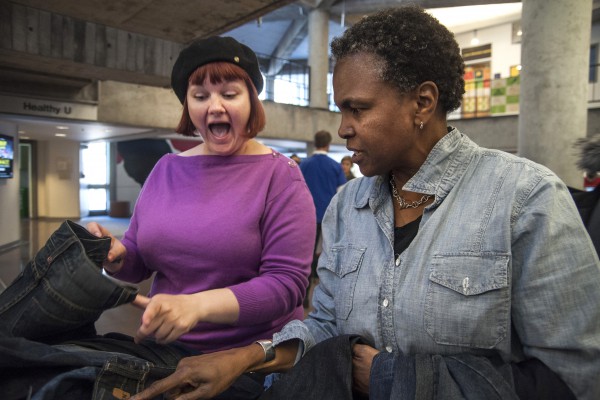Ride your bike to work, drink out of a reusable water bottle, learn the difference between compost and landfill and don’t forget your ripped jeans because this year, bottles and cans are not the only thing students can recycle for Earth Day.
The bottom level of the Cesar Chavez Student Center was abuzz with the humming of sewing machines and excited students rummaging through piles of denim from 11 a.m. to 1 p.m. Earth Day, April 22. Goodwill and Levi’s teamed up with the apparel design and merchandising department at SF State to present the first Levi’s Mendables Sale, an event that allowed students to buy jeans with small imperfections and get them mended on-site.
The garments, which were donated by Levi’s and deemed unsellable by Goodwill because of minor damages, were on sale for $5 a piece, with a fee of another $5-$10 for apparel design majors to repair the damages on the spot.
The proceeds from the event will go to Goodwill’s job training and placement programs and scholarships for SF State students.
According to Tim Murray, who is in charge of branding, marketing and communications for Goodwill, textiles make up 5 percent of current landfill waste. In San Francisco alone, 4,500 pounds of discarded clothing are deposited in landfills every hour.
“It’s an enormous amount of waste that doesn’t have to happen,” said Murray. “So we’re trying to educate people that rather than throw away a pair of jeans that has a hole in it, you can mend it, you can donate it to Goodwill (or) you can upcycle it into a beautiful piece of fashion.”
“Upcycling” is the process of transforming old, useless products into a new product of better quality. The act of upcycling, often used to refer to garments that have been altered in some way, has seen an increase in popularity in recent years. Much like recycling, it’s beneficial to the environment and is a cheap and creative way to reuse old clothing that would otherwise be discarded.
However, Russell Allen Esmus, a ADM student who helped coordinate the event, refrains from using the term “upcycle”.
“It’s the idea of mending, fixing and making it new again,” said the SF State senior. “I think the connotation of (upcycling) is that it used to be trash or something.”

Esmus said the purpose of the event was to introduce the SF State community to Goodwill and restoring used clothing instead of buying new and throwing it away.
He also felt that having fashion students diligently replacing buttons and stitching hemlines would bring awareness about how garments are made.
“Everything you wear, a human had to sew it,” he said.
The event is the first of its kind and was conceptualized by Tim Murray and ADM professor Connie Ulasewicz, who hope to continue the idea of mending used clothing beyond Earth Day.
“I think it should become more than an annual event,” she said. “I think we should have a mending shop. We should be mending all the time.”Murray described textiles as “the new frontier in recycling”. He hopes that holding events like Levi’s Mendables will cause students to be more conscious of textile waste and look good while doing it.






